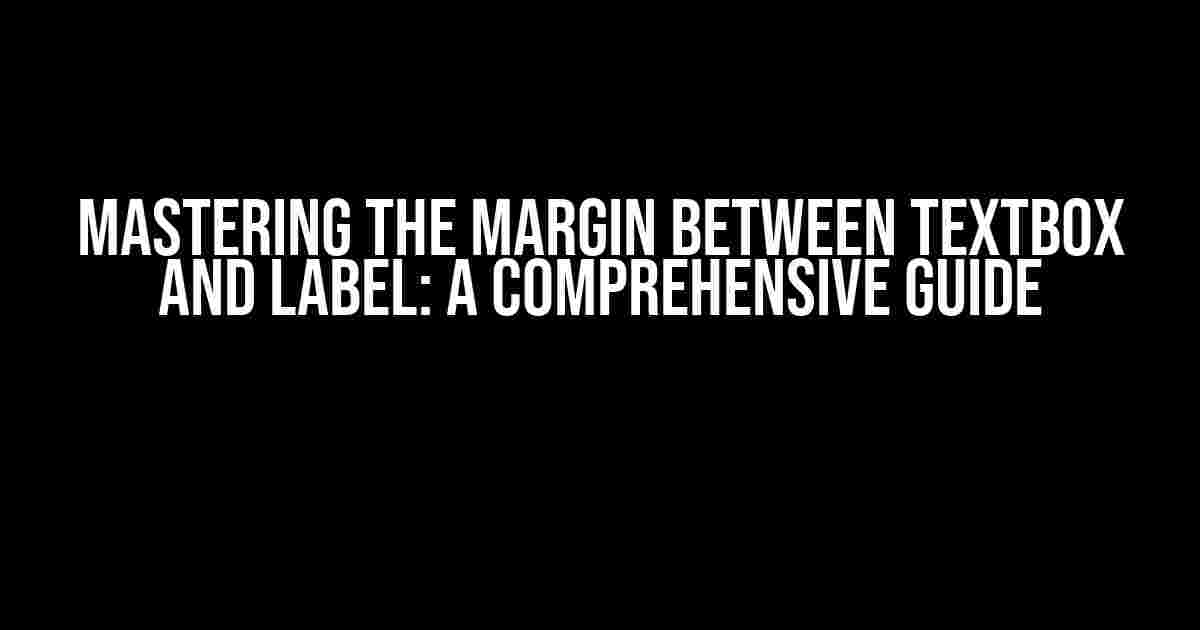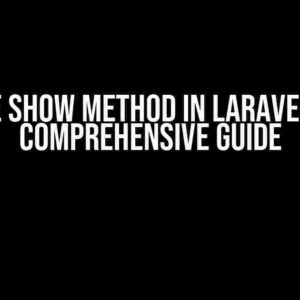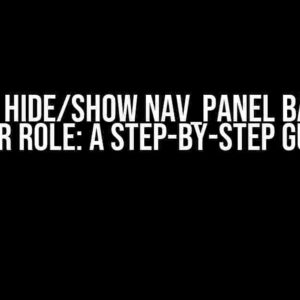Are you tired of dealing with cramped and cluttered forms? Do you struggle to create a visually appealing interface that’s easy to use? The secret to achieving this lies in mastering the margin between textbox and label. In this article, we’ll dive into the world of form design, exploring the importance of margin spacing, and providing you with practical tips and tricks to get it just right.
Why Margin Matters
A well-designed form is all about creating a seamless user experience. One of the most critical aspects of form design is the margin between the textbox and label. This margin can make or break the usability of your form, affecting how users interact with it. A sufficient margin:
- Improves readability by providing a clear visual separation between the label and textbox
- Enhances user experience by reducing eye strain and frustration
- Increases form completion rates by making it easier for users to focus on the input fields
Understanding the Basics of Margin Spacing
Before we dive into the nitty-gritty of margin spacing, let’s cover the basics. Margin spacing refers to the distance between the textbox and label. There are three types of margin spacing:
- Top margin: The distance between the top of the label and the top of the textbox
- Bottom margin: The distance between the bottom of the label and the bottom of the textbox
- Horizontal margin: The distance between the left or right edge of the label and the textbox
Measuring Margin Spacing in Pixels
When it comes to measuring margin spacing, pixels are the standard unit of measurement. The most common margin spacing ranges from 2px to 10px, depending on the design requirements. Here’s a rough guide to get you started:
| Margin Type | Recommended Pixel Value |
|---|---|
| Top margin | 2-4px |
| Bottom margin | 4-6px |
| Horizontal margin | 8-10px |
CSS Styles for Margin Spacing
CSS is the go-to solution for styling margin spacing. You can use the following CSS properties to control margin spacing:
label {
margin-top: 2px;
margin-bottom: 4px;
margin-left: 8px;
margin-right: 10px;
}
input[type="text"] {
margin-top: 2px;
margin-bottom: 4px;
margin-left: 8px;
margin-right: 10px;
}
You can also use the shorthand property margin: to define all four margins at once:
label, input[type="text"] {
margin: 2px 8px 4px 10px;
}
Using CSS Classes for Custom Margin Spacing
Instead of applying margin spacing directly to the label and textbox elements, you can create custom CSS classes to control the spacing. This approach makes it easy to apply different margin spacing styles across your form.
/* Define a CSS class for small margin spacing */
.small-margin {
margin: 1px 4px 2px 6px;
}
/* Define a CSS class for large margin spacing */
.large-margin {
margin: 4px 12px 6px 16px;
}
Best Practices for Margin Spacing
When it comes to margin spacing, consistency is key. Here are some best practices to keep in mind:
- Use a consistent margin spacing throughout your form
- Choose a margin spacing that complements your font size and style
- Avoid using too much margin spacing, as it can make your form look cluttered
- Test your form on different devices and browsers to ensure consistent margin spacing
Common Mistakes to Avoid
Margin spacing can be a tricky business, and it’s easy to make mistakes. Here are some common mistakes to avoid:
- Insufficient margin spacing: Failing to provide enough space between the label and textbox can lead to a cluttered and confusing user experience.
- Inconsistent margin spacing: Using different margin spacing styles throughout your form can create a disjointed and unprofessional look.
- Overdoing it: Too much margin spacing can make your form look sparse and uninviting.
Conclusion
Mastering the margin between textbox and label is a crucial aspect of form design. By understanding the importance of margin spacing, choosing the right pixel values, and applying CSS styles correctly, you can create a visually appealing and user-friendly form that converts. Remember to follow best practices, avoid common mistakes, and test your form thoroughly to ensure a seamless user experience.
With these tips and tricks, you’re ready to take your form design to the next level. So go ahead, get creative, and make that margin spacing shine!
Frequently Asked Question
Get the scoop on the margin between your textbox and label!
What is the ideal margin between a textbox and its corresponding label?
A good rule of thumb is to keep the margin between 0.5em to 1em. This provides enough breathing room between the two elements without creating unnecessary whitespace.
How do I adjust the margin between a textbox and label in HTML and CSS?
You can use CSS to adjust the margin by targeting the label element and adding a margin-bottom property. For example, `label { margin-bottom: 0.5em; }`. Alternatively, you can use the `margin` shorthand property to add margin to the textbox element, like so: `input[type=”text”] { margin-top: 0.5em; }`.
What happens if I don’t add a margin between the textbox and label?
Without a margin, the textbox and label may appear cramped or cluttered, making it difficult for users to distinguish between the two elements. This can negatively impact the overall user experience and accessibility of your form.
Can I use a fixed value for the margin, or should I use a relative unit?
It’s generally recommended to use relative units like em or rem for margins, as they scale with the font size. This ensures that your layout remains consistent across different devices and screen sizes. Fixed values like pixels can lead to layout issues and inconsistencies.
Are there any accessibility considerations I should keep in mind when setting the margin between a textbox and label?
Yes, definitely! A sufficient margin between the textbox and label can improve accessibility for users with visual impairments or cognitive disabilities. Aim for a margin that provides clear visual separation between the two elements, and consider using a higher contrast color scheme to enhance readability.



